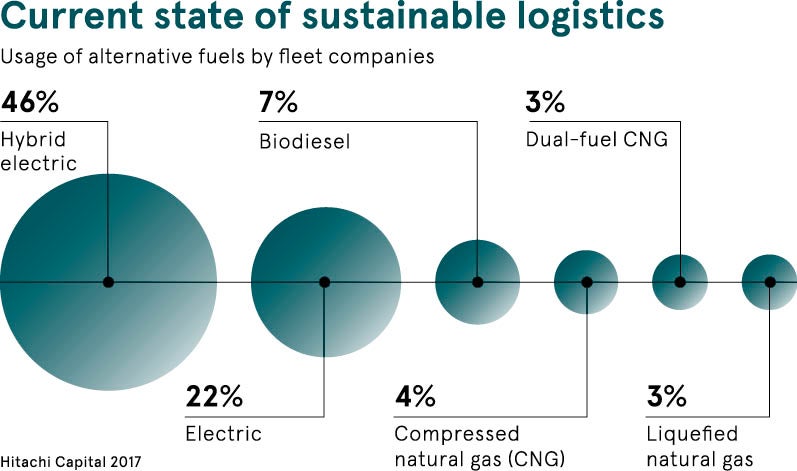If you were to add up the miles all the food, clothes and furniture in your home travelled to get there, it would most likely number in the thousands. We live in a world where we take access to global goods and produce as a given; and this presents both an opportunity and a challenge for the delivery and logistics industry.
It’s an opportunity because as international commerce increases, so too does demand for these companies. It’s a challenge because making more deliveries means producing more carbon and the customers of logistics firms are more environmentally aware than ever. They are also deeply time conscious.
Jagjit Singh Srai of the Centre for International Manufacturing at the University of Cambridge says: “We live in on-demand societies that want and expect shorter and shorter delivery times. I live in an area where I can get an item delivered in two hours, for instance. Rarely as consumers do we look at the efficiency of that kind of activity.”
Corporates that are not investing in new sustainable business models will be out of business soon
Low-carbon logistics are the future of the industry
Whether for business-to-consumer or business-to-business clients, working out how to make fast, global delivery as low-carbon as possible is now key to the logistics industry’s success.
Failure to invest time and capital into resolving this issue could be fatal to these companies, says René Schmidpeter, who leads international business ethics research at Cologne Business School. “It is not a question of willingness anymore,” he argues. “Corporates that are not investing in new sustainable business models will be out of business soon.”
This isn’t purely academic opinion. Delivery firms say their sustainability efforts are already influencing whether they win or lose lucrative contracts. Royal Mail Group operates one of the largest delivery fleets in the UK. A spokesperson for its courier and logistics arm, Parcelforce, says the firm’s ability to prove its green credentials is “an increasingly important factor in tenders”.
Sluggish development of low-carbon vehicles holding progress back
So how to future-proof and make a logistics business more sustainable? Decarbonising the delivery industry requires an arsenal of digital and technological advances, as well as some old-fashioned changes in behaviour. Physical asset management also needs to improve. At the top of the wish list for delivery companies is access to a better range of low-carbon vehicles and the government backing to support their growth.
Christof Ehrhart, executive vice president of corporate communications at Berlin-based logistics firm DHL, says first and foremost delivery firms need the green vehicle industry to grow. “One of the major challenges to decarbonising is the non-availability of low or zero-emission heavy-duty vehicles or aircraft,” he says. “At the moment, progress on the development of alternative technologies is slow, and the legislative environment in Europe and internationally remains heterogeneous.”
Dr Srai says increased consumer pressure and government regulation will be needed to encourage corporates to invest in low-carbon vehicles and for new technology to emerge. “Emission standards, congestion charging, having green zones in cities – these all help drive the sustainability agenda and are crucial to improving industry performance,” he says.
Missed deliveries mean greater carbon emissions
As carbon-reduction regulations vary from country to country, and with few commercially viable, low-carbon ocean, air and road freight carriers on the market, the global logistics industry is driving decarbonisation efforts itself.
Parcelforce says it is working with vehicle manufacturers to develop, trial and use low-carbon vehicle and fuel technologies. DHL’s target is to produce zero carbon emissions by 2050 and the number of activities the firm is undertaking to achieve this is extensive. It has commissioned its own fleet of electric vehicles, is switching to delivering some products in urban areas by bicycle and training staff in greener behaviour. Mr Ehrhart says the firm plans to start planting a million trees a year.
Beyond company-specific measures, Dr Srai says wider development of better digital infrastructure will be key to decarbonising the logistics industry. He points to a bugbear of many online shoppers – missed deliveries – as an area where carbon emissions are at present too high.
“First-time deliveries to homes are not as high as one imagines,” he says. “If you look at some of the major costs and carbon outputs for logistics firms, a lot can be around the last few miles of the delivery journey and repeat deliveries.”
Developing systems that increase the odds of delivering at the first attempt would not only lower carbon output, but could also drive profit by preventing customers drifting to other delivery methods. Dr Srai says he has already noticed a trend is emerging that involves moving away from expensive, unreliable home delivery, particularly in e-commerce. “Consumers are increasingly picking deliveries up on their way home from work or as part of another shopping experience,” he says.
Smart ways to maximise performance in logistics
Maximising the performance of physical assets is another way to cut emissions, curb costs and limit the amount of delivery vehicles piling on to clogged roads. “Businesses need to ask themselves, to what extent are our assets being fully utilised?” Dr Srai says. The practice of “backhauling” could increase, he suggests. “If a truck delivers from A to B, on the return back to A, there is empty space. Backhauling is where you fill that empty truck with a different customer requirement.”
Embracing the concept could effectively double the capacity of logistics firms, but it will require competitors to collaborate.
Dr Schmidpeter points to research that suggests risk-adjusted returns are up to 6 per cent higher for corporates that are integrating sustainability in their value chains. DHL’s Mr Ehrhart says, for his company, it’s simply a matter of playing the long game. Most of their carbon-cutting and sustainability measures, while having a high initial investment and longer payback period, show a positive return on investment.
Low-carbon logistics are the future of the industry
Sluggish development of low-carbon vehicles holding progress back

